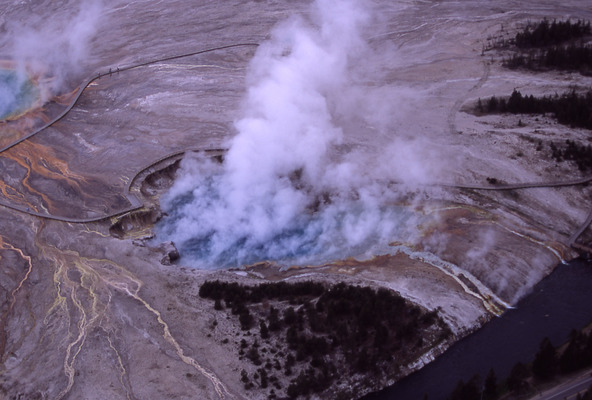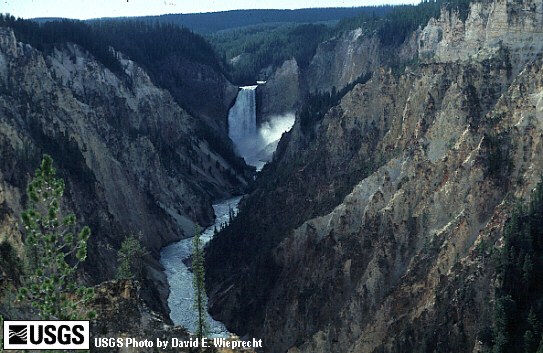
by Alexandra Ossola Thursday, January 5, 2012

Yellowstone's Excelsior Geyser, in the Midway & Lower Geyser Basin, erupts in July 2001. Jim Peaco, courtesy of the National Park Service

Yellowstone Falls, Wyoming USGS Photo by David E. Wieprecht
An abnormally high number of earthquakes has shaken up Yellowstone National Park in the past week. Since Friday, a “swarm” of more than 250 low-magnitude, shallow quakes has repeatedly rattled an area under Yellowstone Lake, with the highest-magnitude tremor — a magnitude-3.9 quake — on Saturday. The seismic activity has raised fears that the quakes may foreshadow a larger earthquake, or a volcanic eruption — but scientists say there isn’t yet reason to fear an eruption.
Yellowstone, situated mostly in the northwest corner of Wyoming, sits atop a hotspot that has produced not only famous geysers but also powerful volcanic eruptions over the past 17 million years. Approximately 2,000 earthquakes shake Yellowstone annually, and having a relatively large number of them strike in a short period of time isn’t especially unusual, says Jacob Lowenstern, a geologist at the U.S. Geological Survey in Menlo Park, Calif., and scientist-in-charge at Yellowstone Volcano Observatory. “Rather than having one main shock and lots of aftershocks, a swarm has lots of events that are similar in size," Lowenstern says. "We get a lot of swarms at Yellowstone." However, he adds, although this swarm wasn’t the largest Yellowstone has seen — that was in 1985, when 1,000 earthquakes greater than magnitude-4 jolted the park over several weeks — it is certainly large enough to be significant.
The geologic process behind such swarms is not well understood. However, Robert Smith, a geophysicist at the University of Utah in Salt Lake City, has an idea as to why many earthquakes of similar magnitude might occur in a cluster, rather than one large shock and several smaller aftershocks. When rocks heated by magma come into contact with water that has found its way underground, the water puts “pressure on the system,” Smith says. But the crust around Yellowstone has been severely broken up because of the several magmatic events that have occurred around the volcano over geologic time. The pressure of the water combined with the pre-existing faults may mean that “the crust can only fracture over short distances,” he says. This yields many earthquakes of smaller magnitudes over longer time, and that’s what’s happening here, says Smith.
Scientists are still unsure about the role of Yellowstone’s caldera in the swarm. The caldera has been uplifting since late 2004, and the earthquakes occurred on the edge of this uplift area. However, with no recent alteration in the uplift rate, it is not clear if uplift is connected to the swarm.
“It is always possible that the pressure causing the uplift has a role in generating the swarm,” Lowenstern says. “But people are still uncertain whether the uplift itself has to be caused by magma intrusions. At this time, there’s no reason to expect that this activity is precursory to any upcoming volcanism.” If a huge volcanic eruption is on the way, though, this definitely won’t be the last warning sign.
“We have never witnessed a large volcanic eruption at Yellowstone; we don’t know exactly what will be precursory,” Smith says. But, if this swarm were indicative of a future volcanic event, Smith would expect the earthquakes to get more intense and more frequent. “If they die away, the energy has been released,” Smith says. And the earthquakes have been decreasing in magnitude since the most powerful quake of the swarm on Dec. 27.
“We haven’t had [a swarm] this size and this duration for decades. It would be very prudent to watch it carefully,” Smith says. Scientists will continue to keep watch on Yellowstone in case more violent signals appear.
© 2008-2021. All rights reserved. Any copying, redistribution or retransmission of any of the contents of this service without the expressed written permission of the American Geosciences Institute is expressly prohibited. Click here for all copyright requests.